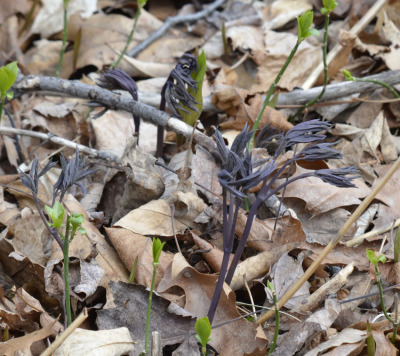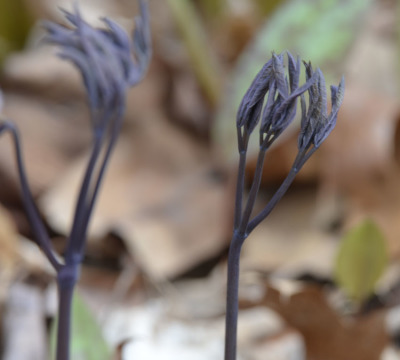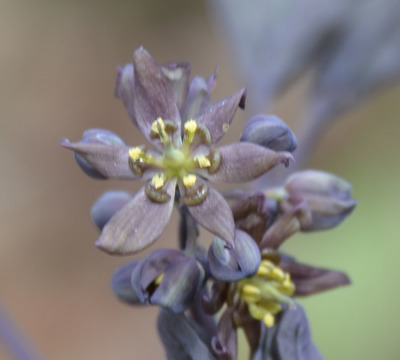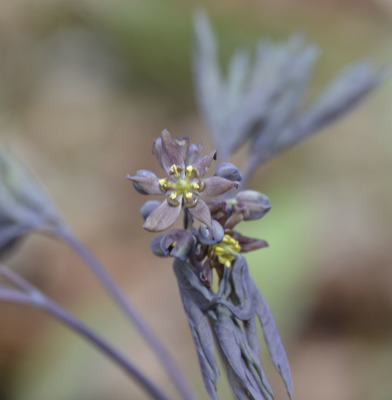While walking around a woodland trail in southern Ontario in April, I noticed a strangely coloured plant. The stems and leaves, and even flowers, looked purple. Or maybe blue. Or grey red. It was a strange colour to describe but very different from any of the surrounding shades of green or brown.

These odd coloured leaves caught my eye.
What Made Me Notice this Spring Ephemeral With 6 Petals?
The plant had long bare stems already taller than 8 cm (4 inches) that ended in leaves that looked windswept and were not open yet. The most noticeable feature was the purple blue grey colour of both the stems and the leaves. If they had been green, I might have believed they were some type of fern unrolling.
The weather wasn’t great but I took a few quick photos. Then I realized, while focusing, that there were some yellow dots at the ends of a few plants. A closer look at others along the trail showed that some were in bloom.
The purple blue grey flowers had 6 petals or sepals with tiny yellow dots for the stamens and pistil.
I thought this strange colouring would make it extremely easy to identify with my field guide at home. I was wrong!
How Did I Discover This Was Wild Blue Cohosh?
A page-by-page walk through two field guides suggested Cohosh was one of the few possibilities. An internet search for Spring Wildflowers also gave a list, in blooming order, of common woodland ephemerals. Blue Cohosh was on that list.
Checking the images on the internet for Blue Cohosh settled the issue. It looked just like some of the photos, particularly the ones on the Wildflowers of Prince Edward County, Ontario, website.
Will the Withered and Wilted Looking Purple Red Leaves Stay that Way?
No. That’s what made this plant particularly hard to identify instantly with the field guide. Very soon the leaves will unfold, the green chlorophyll will dominate and they will become “regular” coloured leaves.

Some leaves were already starting to unfold.
Why are they this odd colour?
I’ve noticed some other plants send up red-toned leaves in the early spring. According to the Hilton Pond Center for Piedmont Natural History website some red-tinted spring leaves such as those of White Oaks have anthocyanin in them. It acts as a protection against UV light for the newly opening leaves.
I couldn’t find confirmation that Blue Cohosh is using the same protective technique, but I suspect it is.
Isn’t Blue Cohosh One of Those Herbal Medicines?
I thought the name sounded vaguely familiar from magazines, and sure enough Blue Cohosh is an ingredient in some herbal medicines. The Ontario government even has some recommendations for how to cultivate it. Apparently an essential oil can be distilled from the leaves—after the plants have been grown for 4-7 years! And it says that the plants may be eaten by “Black-patched clepsis caterpillars.”

Here I could see that the leaves will gradually open possibly into three parts.
The Agriculture and Agri-Food government of Canada website has quite a bit of info on this plant.
One thing I found out is that I was probably looking at “purple flowered Blue Cohosh” as opposed to “yellow flowered Blue Cohosh.”
Update:
For clarity, my kind is Caulophyllum giganteum Early Blue Cohosh. It blooms about two weeks earlier than the next one. Early Blue Cohosh is the purple flowered kind.
There is another one, which has yellow-green flowers called Caulophyllum thalictroides, or Blue Cohosh.
I guess that’s why I should use scientific names more often than “common” names!
Blue Cohosh, it says, like to grow in maple woods on limestone. That could explain why I’m not familiar with it, as most of my spring wildflower experiences come from granite country.
The medicinal uses of Blue Cohosh usually relate to women’s issues such as inducing labour. It can cause muscular contractions and high blood pressure. The government website cautions that Blue Cohosh is not as well studied nor is it believed to be as safe to use as Black Cohosh.

The odd colour of the “blue” flowering Blue Cohosh.
I have no intention of trying to concoct any medicines, although I will admit to eating the odd wild strawberry purely for the vitamin C, so my interest in the Blue Cohosh was simply in its odd colouring. If I’m back later in the year, I’ll see what the leaves look like and keep an eye out for its blue berries.
Related Reading
- What Bright Red Corn Like Berries Are Growing on this Bare Stem and Black Mushroom Like Plant?
- Invasion of the Buttercups at Riverwood Conservancy, Mississauga
Join In
Did you know at first glance that this was a Blue Cohosh plant? I admit that now I know its name I’m not likely to forget it since it was so different from any of the other spring beauties I’ve seen. If you have it blooming near you, please share your insights with a comment.


Thanks for your work … this confirms what I discovered last week on the Bruce Trail west of Cherry St., Lincoln. Isn’t called Purple (vs Blue) Cohosh though?
I’m glad you found some too! The common name seems to vary a lot for this plant. I’ve updated the article to add a bit:
This one is Caulophyllum giganteum sometimes called “Early Blue Cohosh” and other times “purple-flowered Blue Cohosh.” It’s not Caulophyllum thalictroides which is sometimes called “yellow-flowered Blue Cohosh” and other times called just “Blue Cohosh.” Either way it is a Blue Cohosh.
I just saw this plants in the woods of Haliburton.
Beautiful and different!
The first time I saw the plants I thought someone had spray painted them! They are quite interesting in colour–thanks for sharing!